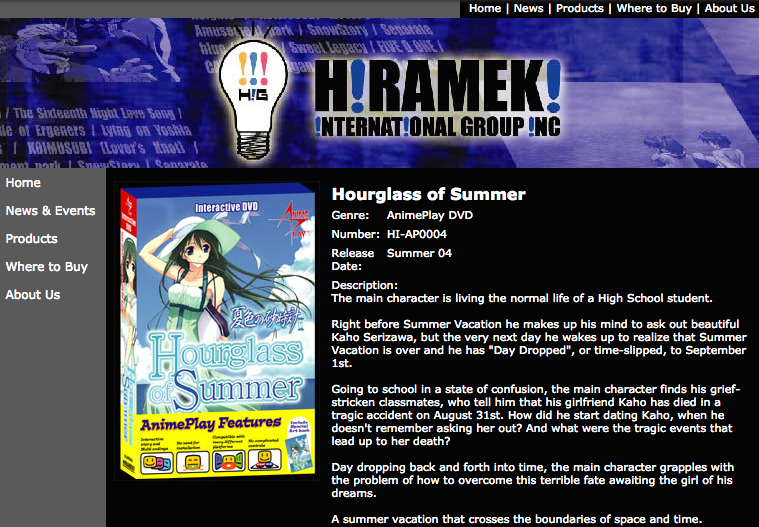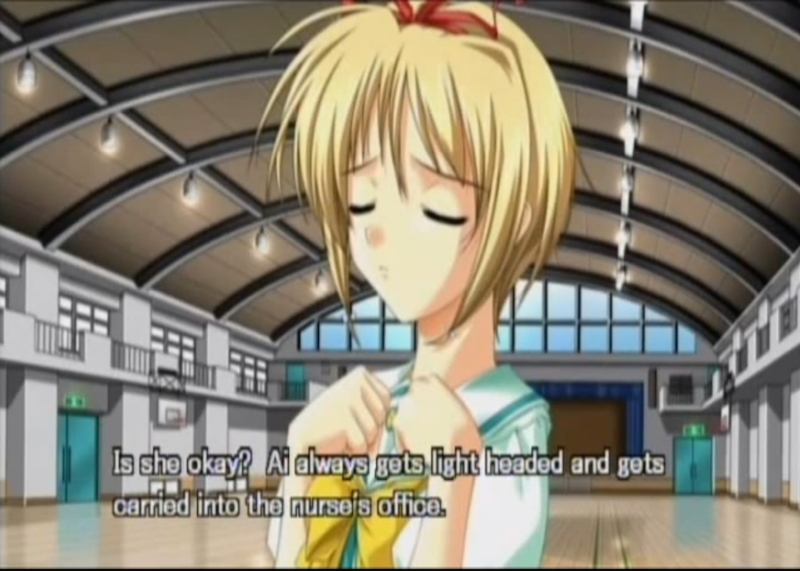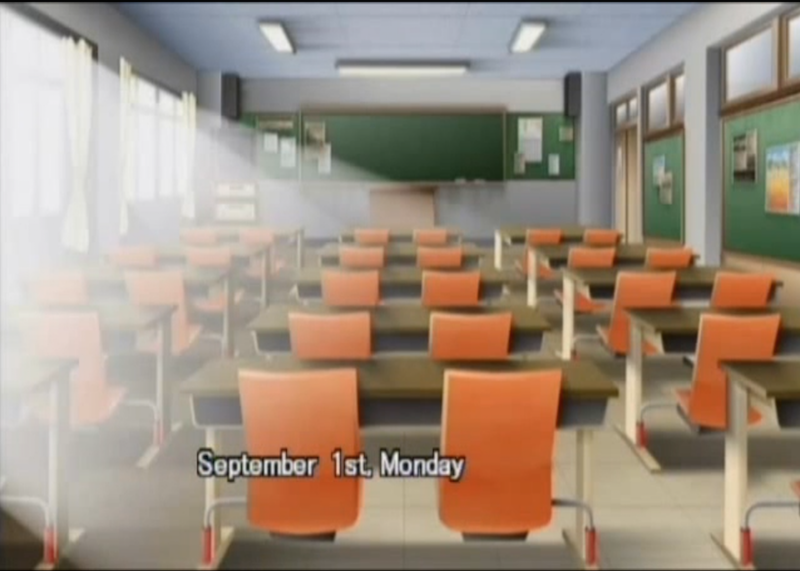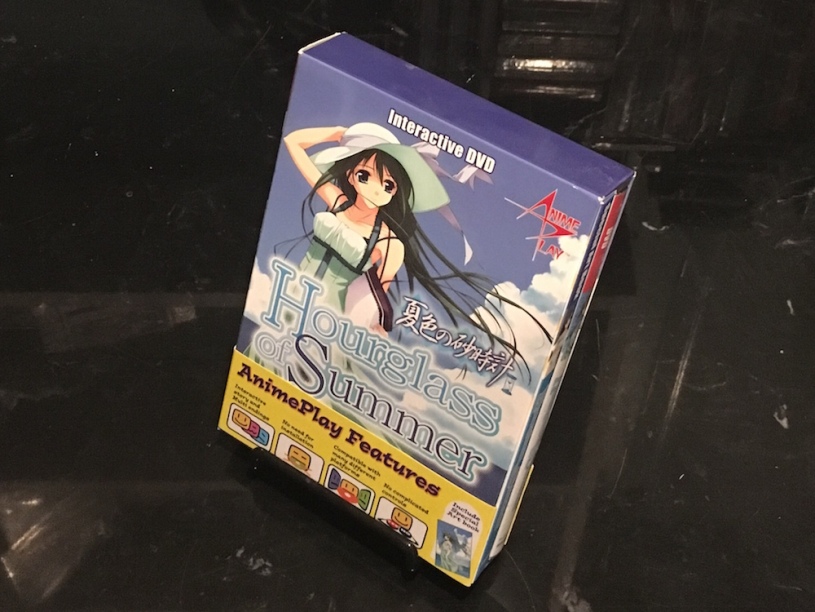You’re looking at an interactive DVD game from Hirameki International called Hourglass of Summer. Never heard of it?
Hirameki International was a company that specialized in bringing over visual novels to the United States. I’ve looked at quite a few visual novels in this blog, but this is not only the first interactive DVD visual novel I’ve looked at but the only one I’ve actually played. However I’m personally not unfamiliar with this sort of “interactive media.”
If you yourself reading this are however unfamiliar with “interactive media” it has existed for a relatively long time and near mirrors the home console market. Some of the earliest mass spread interactive media was on Laserdisk, and famously were games like Dragon’s Lair that were as simple as moving a joystick or pressing a single button and eventually became more complex including games such as Who Shot Johnny Rock? and Mad Dog McCree.
Yet that’s cheating right? These are video games. Right?
Where these games initially differed from their contemporary arcade brethren is most arcade games of the day were stage format primarily spurred by pushing high scores. Most interactive media titles on the other hand – most famously Dragon’s Lair, for an example – had some sort of narrative and could be completed incredibly quickly once a player knew all the correct moves and progression. Where quarters were ate up was early on when a player was having to learn all the intricacies of what to press or move at what moment.

Interactive media quickly moved onto all sorts of home -accessible formats. I quite vividly remember VHS interactive board games sprouting up around this time period, mostly centered around sports like football and hockey (one was even released for the World Wrestling Federation). These “games” used recorded scenes edited together that would be played until set stop points were reached, then you would stop the VHS tape to perform whatever was next on the board, then resume. It was novel at best to see live action on any sort of gaming medium at home and at it’s worst comical considering nothing changed; it was the same footage every time you played the tape progressing at the same rate.
Interactive media in the very late 1990s eventually moved to DVDs, yet it had a very rough start. Companies did not know the best way to apply this sort of technology to DVDs and worst yet DVD encoding was still in relative infancy. There never was – and arguably still isn’t – decided upon standards for DVD codecs and file quality as most companies would encode DVDs for whatever they were particularly selling. Let’s go back to Y2K. Buying a DVD movie at the time? Likely looks very good, even played back today. Buying a DVD that contains 12 episodes of anime? It… probably doesn’t look very good on a modern television, as the footage would be heavily compressed to fit onto a single DVD.
Yet despite all of this companies still experimented with DVDs. If companies didn’t included outright extra DVDs, often various releases would include extra content accessible through menus. Sometimes mini games or similar would come with a DVD, played through the DVD player’s remote. It was “interactive media.”
Here’s where Hirameki International comes in.
Hirameki was founded in early 2000; prime time for anime as it was both moving away from VHS to DVD media and – probably more notably – moving away from cels to more digitally-created animation (with digitally drawn anime bringing about more simpler, often ‘moe’ designs). I’ve looked at a LOT of games from Japan from the 1990s but anime & manga games in the year 2000 were still painfully niche’. Anything that had any sort of direct anime or manga tie was still a very risky gamble to attempt to localize, and eroge & similar visual novels were still primarily mail-order only through places like JAST USA.

Hirameki started to bring over Japanese visual novels to PC. As we’ve touched slightly upon however, keep in mind that even up to Y2K computers in the household were still relatively rare. For many families computers were the sorts of things that you either accessed at school or went to the local public library for. Couple the issue with how to sell the media in the first place – most of these companies did not rate their visual novels through the ESRB and so consequently they did not appear in computer gaming sections of places like Electronics Boutique or CompUSA – and I’m certain Hirameki realized PC visual novels were incredibly specialized.
What wasn’t specialized however was DVDs, even anime DVDs by this point.
Hirameki early on released a good deal of visual novels that had shovelware’d themselves back and forth between say PC and something like Playstation2 during the time period. As I’ve talked about until my face has been blue, visual novels jumping around formats was not uncommon in Japan. For the most part games would first release on PC, then they would find themselves ported to various home consoles in some capacity. Often the PC version would be Top Dog; best features, most attention to detail, and – in many cases – for adults. And home console versions would exist to push the games to people that, similar to the United States, didn’t have a computer at home.
What was… novel (har har)… about visual novels also was these games are incredibly simplified. Most visual novels are exceptionally static with just menus choices, and some have even gone further where they are quite literally just things you read and watch with NO choices. Something that has the ability to progress by just hitting menu buttons is something that can easily be manipulated with a DVD remote; you don’t need a controller or keyboard for it.
So Hirameki decided to bring over visual novels as DVD “interactive media.” Immediately two things were in their favor. First, they were the only company attempting to localize games in this manner, since others either localized typical console games or, again, were very niche’ such as JAST USA. Second… these were DVDs. They could sell alongside anime at your local Suncoast or specialty store with an anime section and didn’t require ESRB rating.
YEAHhhhh… see where this is going? I’d like to find whoever came up with this for Hirameki and shake their hand.
So lets finally get to talking about Hourglass of Summer (Natsuiro no Sunadokei, 夏色の砂時計 )
HoS [you’re used to my abbreviations by now] was created by PrincessSoft in 2002 and would be released by Hirameki on DVD format in 2004. Crazy enough PrincessSoft themselves were not particularly known for visual novels and often worked on porting other companies’ visual novels to consoles. They had worked on all sorts of circa titles including 21: Two One, a game from BasiL which has a lot of staff that would eventually go on to work for Navel and also create the circa-immensively popular series Shuffle, and PrincessSoft also ported middle of the road -known titles such as Kimi ga Nozomu Eien that for a short period of time were decently popular. Hourglass of Summer would be a game the company themselves would actually create. Character designs are by Murakami Suigun, who to this day dabbles in erotic and fetish artwork.

The story is about Kotaru Makimura. The end of the school year approaches, and he tells his two friends Ai (a childhood girl friend) and Takeshi (the atypical ‘dude’ friend) that he wants to confess to his crush, Kaho Serizawa. On the way home Kotaru comes in contact with a stranger, and when he goes home and sleeps he wakes up to find out that he not only has jumped ahead to the next school year in the fall, but that he apparently HAS been dating Kaho and she died in an accident over the summer.
Kotaru comes to realize that he can jump between days during the final part of the school year and throughout summer, so he works to try and prevent Kaho’s accident from happening. Of course this is a visual novel with routes, and as such Kotaru doesn’t necessarily HAVE to pursue Kaho and is free to pursue a variety of girls including his friend Ai.
A game where the title literally describes the narrative…
It’s actually a very lighthearted visual novel, striking of which for it being a very early PrincessSoft game it’s all put together very well. It’s translated decently (I’ve only come across some instances of misspelled words, likely needing more proofreading). Most striking however is the protagonist is not silent and narrates ALL of his inner monologue. This is uncommon for visual novels, as the idea of viewing the game from the protagonist’s point of view and reading the dialogue is you insert yourself into the character. As the dialogue is narrated the narrative auto-moves, meaning you have to keep up with what is being said.

There was likely a reason for this decision. Technically each ‘scene’ is a track on the DVD which is how the ‘game’ progresses. There’s effectively no interaction by the player [so much for ‘interactive media’…] other than at key menu choices. Having the monologue narrated in addition to all the other characters allows the game to auto-progress, at the expense of really needing to pay attention. There was likely a further technical aspect behind having little interaction, as you don’t have to program in particular visual novel or dating sim functions like looking or moving around.
You progress through the menu selections that do periodically pop up by using a DVD remote (or, if you did happen to play it in a PS2 or XBox during this time with a controller). The game is IN-CRE-DI-BLY static; almost painfully. Modern visual novels typically have some sort of small character animations in dialogue screens even if they’re 2D format. Here however you get a portrait of the character (that changes with expression), dialogue that isn’t separated visually from it’s background, and honestly I feel the character portraits are a little TOO large. When speaking with one character they nearly fill the entirety of the screen, and if another character joins the conversation the portrait awkwardly moves in frames to the side of the screen. It can be rough to look at.
As it’s a DVD there’s no real way to ‘save’ or similar. The DVD generates passwords for particular scenes, which have to be written down and utilized to return to a particular portion of the DVD. Consequently as scenes range under roughly five to ten minutes and multiple routes exist there are TONS of potential passwords. On the flip side however is this being a DVD it’s compatible with a wide range of players. For this review – it’s been over a decade since I last played this game – I was able to put the DVD into my [older] Mac and play it just fine.
HoS itself was somewhat of a strange visual novel in regards to it’s release. It actually released first on the PS2 as a standard visual novel console title. Later it released on PC with adult content added. Hirameki’s version of the game is the PC game, without the adult content, but compatible on a PS2 as a DVD movie! … … What?… Eventually a two part OVA also released with key animation by Rikuentai and Picture Magic, two companies more known for in-between animation more so than key work, and ultimately served as fan-service for players who had played HoS.
Hirameki would continue to release similar titles. Hourglass of Summer was the only one I bought, and honestly I bought it out of absolute sheer curiosity when I saw it on a shelf. My general understanding is despite intentions these games had some difficulty selling at retail. Not only did you, again, have to actually be lucky that your local retailer carried it, but the price was in most cases $30 – $35, for something that you effectively weren’t sure how it would proceed (and to be fair, despite Hirameki’s intentions some circa-DVD players had compatibility issues). Hirameki eventually folded in 2008, only to return to produce third-party console peripherals.
As for “interactive media” it’s effectively gone the way of the dinosaur in this ideology, however it does continue to live on in optical media extras and as other sorts of tools primarily for edu-tainment purposes. Nowadays with deliverables such as Steam games such as visual novels and dating sims can release digitally. Despite these advantages, I’m certain one could argue they’re still relatively niche’… and cringe.

